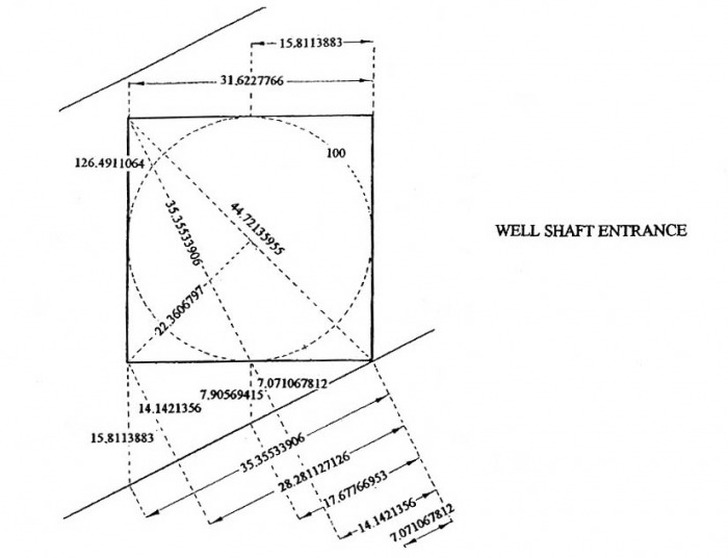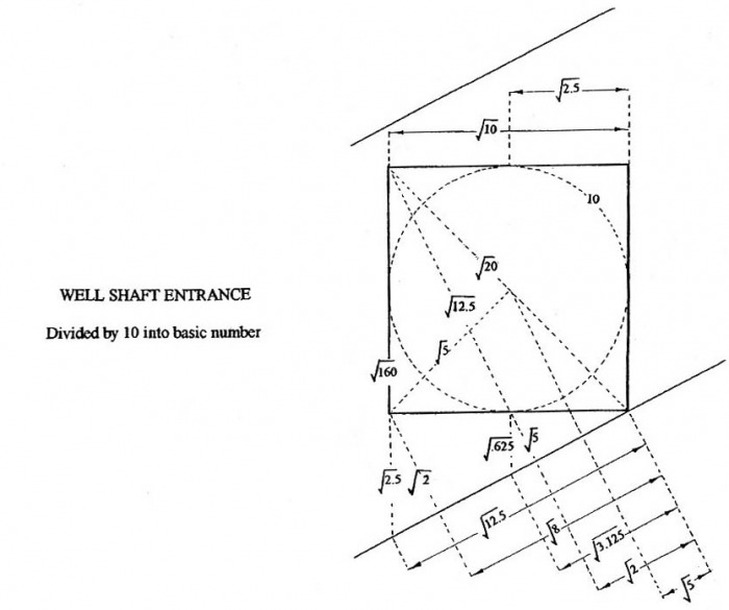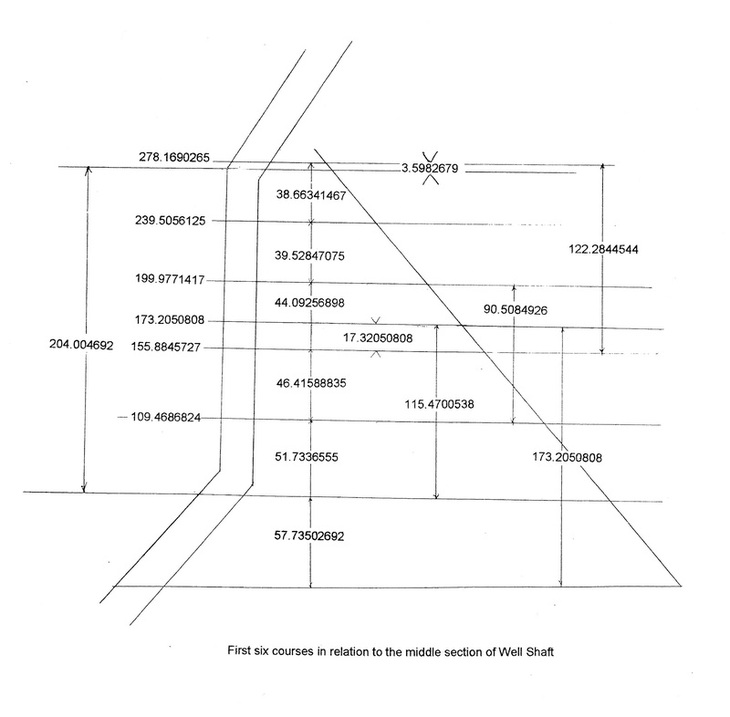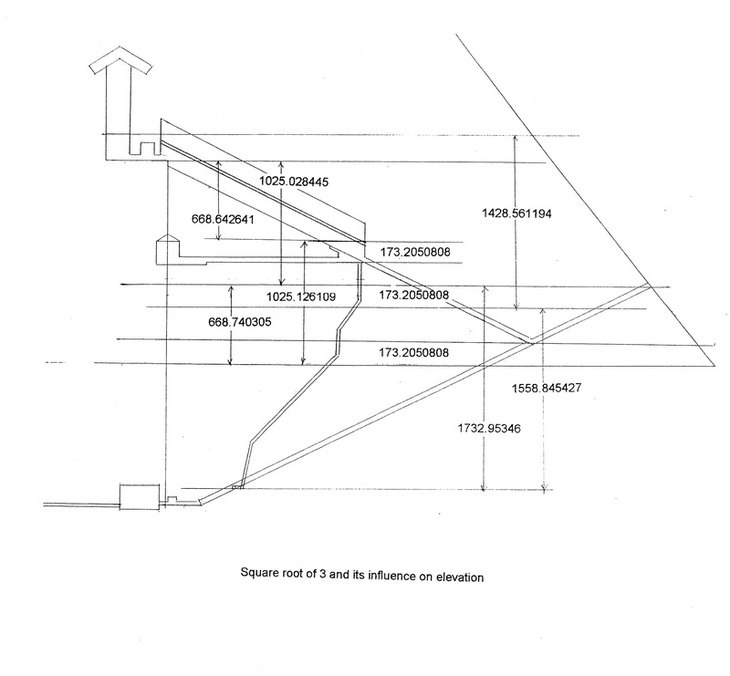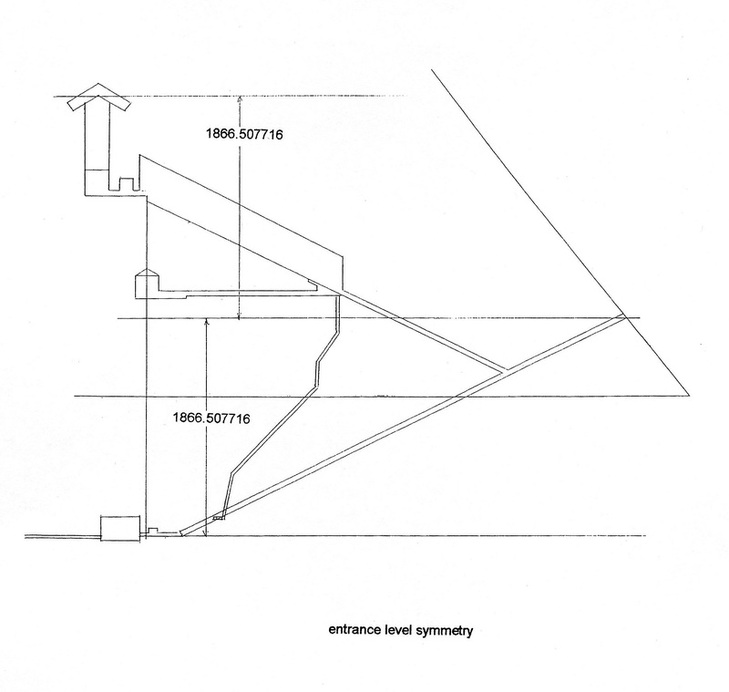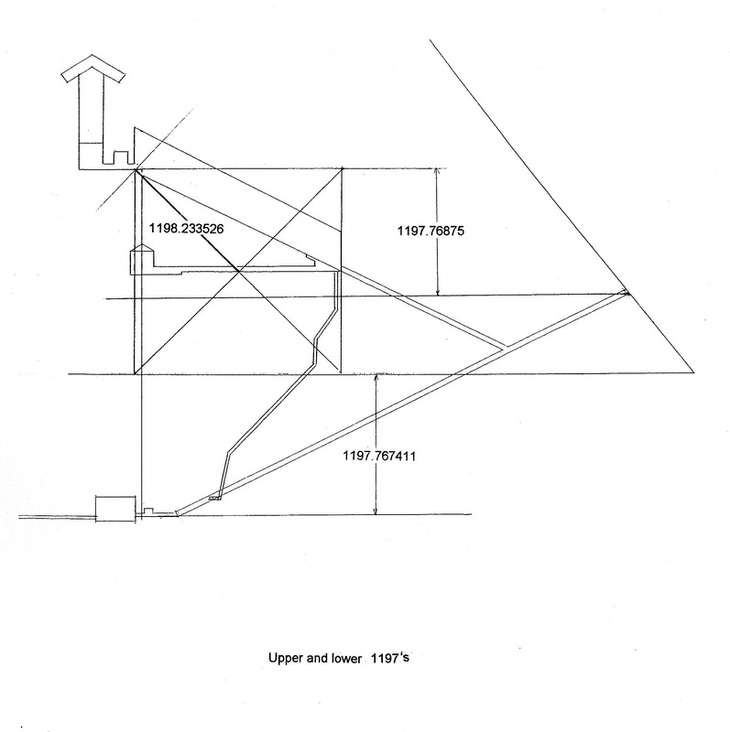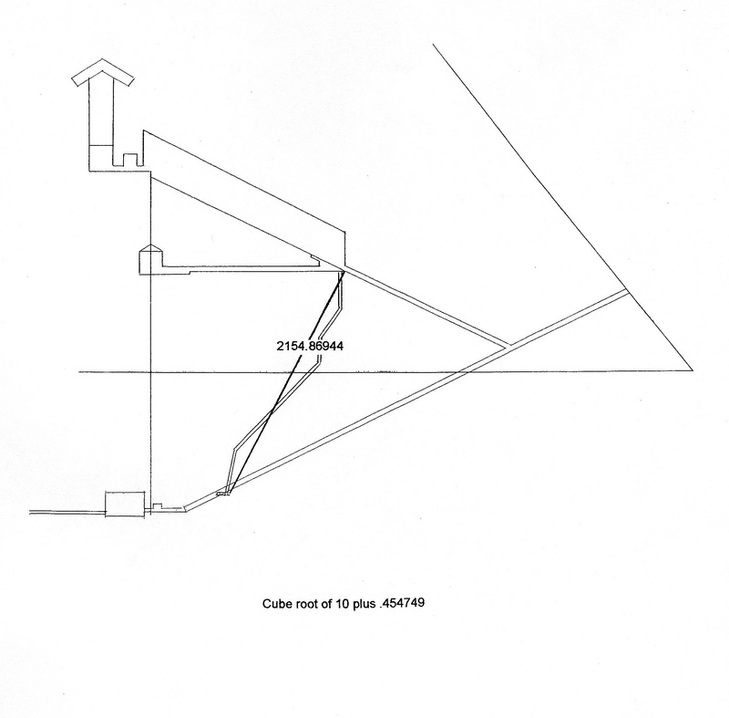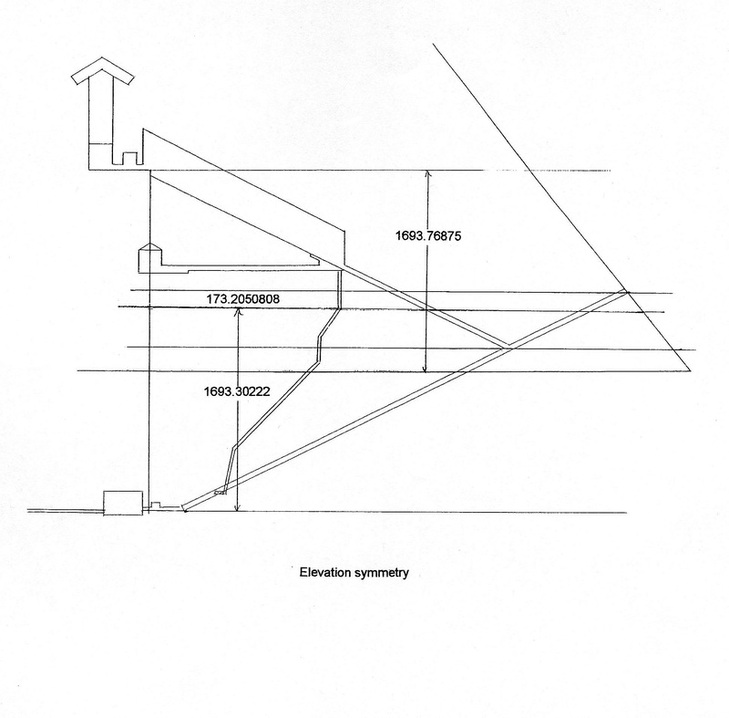The Mathematics of the Great Pyramid
The Well Shaft
The upper mini passage defines the westward displacement of the Well Passage, which has the same North-South axis as the main passage system. It is 90.50966799 inches west of the main passage system, and with the same square as the main passage displacement of 286.2167011, divided by 10, 8192 and 81920 respectively, making their ratio the square root of 10, 3.16227766.
The bottom entrance has the same width and height of 31.6227766 inches, creating a square with a perimeter of 126.4911064 inches (the square root of 16,000), an area of 1000 inches with an inscribed circle having a 100 inch circumference. This defines the passage as a member of the square root of 10 world, in which the square root of 5 is one side of the inscribed square in a circle of one, which its entrance is when reduced to its essence. Whereas the route through the Ascending passage to the Great Step is the ratio between Fourth Line and the circle, the Well of Life passage IS Fourth Line.
The measurement from the northern edge of the bottom entrance horizontally to the northern edge of the upward passage is the transformative 70.71067812 inches (the inverse of the square root of 2). This number will be encountered again as the measurement of space between the last floor joint and the King’s Chamber. The length of the passage route between these two transformative numbers is 4346.232278 inches. The square of the square of this number, after moving the decimal point, is 3568.220893 inches, the golden proportion of the pyramid’s height, no small accomplishment considering the quantity of separate measurements between the two.
The sum of the entrance and its mini passage to the northern side of the bottom of the shaft is 102.3334547 inches, a number with many connections. The ratio between the two sections is the square root of 5, a thousandth of the passage itself. In the square root of 10 world, it plays many roles, one of which is the ratio between one side of the decagon (ten sided polygon) and the circle. The decagon’s ratio to the radius of a circle is the golden proportion, so that in the Great Pyramid’s circle, one side of the decagon is 3568.220893 inches.
The sum of the lengths of the three upper sections, which can only be what they are, determines the total length of the bottom two sections needed to bring the total up to 2236.06797 inches. This is 1407.063508 inches and could be divided any number of ways into significant numbers. The Well Shaft is clearly the most difficult place in the pyramid to measure. The best of these possible divisions that are within the parameters of the known measurements is a division so that the bottommost section is 362.7897263 inches and the next is 1044.273782 inches. The bottom section is .0123821 greater than 362.7773439, the pyramid’s perimeter divided by 100. But even closer is 362.7896731, which is the square of the ratio between the lowest and highest pi used in the pyramid, 3.140328164 (the north side pi) and 3.16227766 (the square root of 10), multiplied by 35. 77708764, a difference of .0000531.
The longer section, 1044.273782 inches, is 1000 times the square root, of the square root, of the square root of the square root of 2, and although quite distant from the square root of 2, it should nevertheless, be considered to have all the same attributes. Because it is the ratio between the side of a square and its diagonal, which then becomes the side of a larger square, and the radius of a circle, it represents (with an assist from Third Line’s action principle) growth, change, transformation, and the second dimension as a whole. In the great Pyramid, the square root of 2 takes the climber up to base of the pyramid and then on into the pyramid proper, illustrating its transformative principle. It then connects with the first vertical passage just above the first course of stone.
The first vertical section of the shaft is 204.004692 inches in length, which is the square root of the square root of the square root of 300, times 100, and passes through of the second through sixth courses. These courses, including the first course, and various combinations of them should be considered horizontal zones of influence of the number’s symbolic aspect.
In spite of the very precise leveling of the foundation, there are very few courses that have consistent thickness throughout the course or the same elevation from the base at the four corners. Of the first six courses, only the fourth course has less than an inch variation in thickness and elevation at the four corners. But, because of the courses interaction with each other, the measurements of the first six courses can be deduced.
The first course has a 2.4 inch variation in the thickness of the four corners, but the height is clearly intended to be 57.73502692 inches, one hundredth of the height of the pyramid, as well as being the ratio between Sixth Line (the radius) and Third Line. This makes the first course and the first 481.125 inches from the pyramid entrance to the score lines, both beginnings, reflect the same ratio, one in inches and one in its foot equivalent.
The measurement from the top of the first course up through the second and third courses to the 173.2050808 inch horizontal plane of the junction between the Ascending and Descending passages that runs through the fourth course, is 115.4700538 inches. This is the diameter of the pyramid’s circle as well as being the ratio between Second Line and Third Line.
The second course has a 4.9 inch variation between the thickness at the four corners, and the third course has a 5.1 inch variation, so there is a wide range of possibilities. The elevation of the top of the third course, 155.8845727 inches, helps define the total thickness of the second and third courses because of its relationship with the 173.2050808 inch line running through it. The distance between the two numbers is 17.3250808 inches, the square root of three times ten.
Of the many possibilities for the individual thickness of the second and third courses, (the sum being 98.14954582 inches) a good estimation would be 51.7336555 inches for the second course and 46.41589028 inches for the third course. The significance of the third course’s thickness is that it is the square root of 2154.434691. This is the measurement of a straight line from the bottom north corner of the Well passage up to the junction of the Ascending Passage and the Grand Gallery. 2.15434691 is the cube root of 10, and the only number whose square, square root, and inverse are, except for placement of the decimal points, the same number. It is probably the most important number in the Well Shaft, if not the whole pyramid.
The fourth, fifth and sixth courses add up to 122.22844545 inches, which is the square root of the square root of the square root of 5, times 100. The thickness of the course in between, the fifth course, is 39.5221457 inches, one hundredth of the earth’s radius in the idealized world of the square root of 10.
From the 173.2050808 inch plane to the top of the middle vertical section of the passage, there are 101.36556774 inches. When added to the remaining distance up to the junction of the Ascending Passage and the Grand Gallery, which measures 577.3502692 inches, (a tenth of the pyramid’s height) the sum becomes 678.7159471 inches, (a tenth of one side of the pyramid circle’s inscribed pentagon as well as the ratio between Third an Fifth Lines).
The next section of the Well of Life passage is slanted and measures 312.2248619 inches. Its vertical component is 264.5751311 inches, the square root of 7, times 100. This is first use of the square root of 7, which is a major component in the Queen’s Chamber passage, its length being the square root of the square root of 7 times 1000.
The fifth and last section is vertical, measuring 312.7751381 inches in height and 165.7840891 horizontal inches north of the middle vertical section. The significance of these last two of the five sections, is that they add up to 625 inches, 25 squared. And the ratio between 625 and 2236 06797 is 3.577708764.
Another use of the square root of 3 is the vertical measurement between the bottom of the Well Shaft and the elevation of the pyramid’s entrance. This is 1732.95346 inches, which, though not the square root of 3, it can be taken as a symbol of it. The same goes for the vertical distance from 173.215315 inches below the entrance height, up to the top of the King’s Chamber. This measures 1428.561194 inches, the inverse of 7, minus one hundredth of an inch. These two numbers play an increasingly more important part in the Queen’s Chamber and Passage.
The sum of the symbolism of all these Well Shaft numbers suggests that although the original design (up the Ascending passage and Grand Gallery to the Great Step to complete the Fourth Line root of 4472.i359 inches) works for all other forms of life, but that the ratio is not enough for our species and must consciously experience first hand, boots on the ground, the physical reality of the 2236.06797 inch Fourth Line, and that quite possibly the Well of Life passage is a substitute for the entire Queen’s Chamber and its passage.
This concept is reinforced by a number of factors. The first is that the direct line from the Well’s entrance to exit is 2154.434691 inches. Divided by a thousand, this is the Cube root of 10. As a number it is the only number, whose square, square root, and inverse are all the same number, except for the place of the decimal point, and continue the replication infinitely, whether going forward or backward.
The principle behind this is that everyone must climb their way through life on his-her own, in order to achieve a more perfect union between spirit and matter. Like the concept of karma, no matter what the condition of your life is, and no matter what choice of path you make out of all the possible paths, you always meet yourself and the problems of your own particular reality, no matter who you are or where you are.
The second factor is that the distance from the pyramid’s entrance down to north edge of the Well Shaft entrance on the Descending Passage floor, and then up the Well Shaft to its exit into the Grand Gallery, is 6087.499951 inches, which, times six is 36524.99971. This is .0077984 greater than 365.242198781, the tropical year, one of the three ways to measure the time of the earth’s current orbit around the sun. It is .0063684 less than 365.25636556, the sidereal year and .0096442 less than 365.25964134, the anomalistic year, and .0027 less than the mean of the three. This route is clearly the earth bound route for perfecting the union between spirit and matter. It represents the transition from one state into another.
The third factor is the entrance itself. It is square with a side of 31.6227766 inches, an area of 1000, a diagonal of 44.72135955 inches (10 times the Fourth Line to First line ratio), with the circumference of its inscribed circle measuring 100, containing an inscribed square with a side of 22.3606797 inches. There are 22.3606797 inches from its north corner on the Descending Passage floor to the center of the circle. Reduced to its essence, it is a square containing a circle of 1. So, just by entering the Well of Life Passage in order to climb the 2236.06797 inches, one is passing through a circle in which the inverse of every regular polygonal line is the ratio between it and First Line, which represents All in the square root of 10 world.
The measure between its sides dropped vertically on the sloping floor of the Descending Passage is 35.35533906 inches, the same measurement of the height of the Great Step. Together they add up to the transformational 70.71067812 inches, the inverse of the square root of 2. As most of the numbers between the entrance and the Descending Passage floor, and the divisions on the passage floor are transformational numbers, it is safe to say that the Well of Life represents the transition from one state into another.
The fourth factor is the length of passage line between the 70.71067812 inch mini passage from the Descending passage at the Well Shaft’s bottom, that has to be crossed before climbing up to the Grand Gallery, ascending the Grand Gallery, up and over the Great Step, through the Anti-Chamber to the last floor joint, which is 70.71067012 inches from the entrance to the Kings Chamber. This measures 4346.232267 inches. The square of its square, after sliding the decimal point, is 3568.220893 inches, the golden proportion of the pyramid’s height. Now considering that the distance from the south corner of the Well entrance on the passage floor, to the end of the Dead End Passage and back to the same point is the inverse of the pyramid height’s Golden Proportion, this in between distance has to be one of the most difficult features to be incorporated into the Great Pyramid’s design.
Another aspect of the Well Shaft is that the sum of the three upper sections, 829.0044692 inches, is but .6604003 inches greater than the sum of the horizontal measurements between the vertical plane of the north wall of the Grand Gallery and the center of the pyramid’s North-South axis (the length of the Queen’s Chamber passage, plus half the width of the chamber, 1626.576562 inches) excluding the bases of the two triangles formed by the two bottom segments of the shaft.
The total vertical distance from the Well entrance to the exit at the junction of the Ascending Passage and the Grand Gallery is 1916.134183 inches. The floor of the shaft’s bottom entrance is 1064.213155 inches below the pyramid base, and 1732.95346 inches below the plane of the pyramid entrance, nine tenths greater than the square root of 3, but relevant nevertheless. The vertical distance from the Well entrance to the junction of the Ascending Passage and Descending Passage is 1225.196702 inches.
The floor distance from the Ascending and Descending passages junction to the Well entrance and up the Well shaft to the Grand Gallery and Ascending Passage junction is 4977.453624 inches, 3430.902835 inches longer than the direct route via the Ascending Passage. Including the Subterranean Passage and Dead End Passage, the route is 8213.24404 inches, 6666.693251 longer than the direct route.
Given the quantity of separate measurements that comprise this extra subterranean route, the .0265852 difference between it and 6666.6666666 could easily be the accumulation of minor errors. The square root of 66666666.66 is 8164.965809, which is one side of the pyramid circle’s inscribed square, or Fourth Line. Divided by the square root of 2, it is 5773.502689, (pyramid height and ratio between Third Line and Sixth Line) and multiplied by the square root of 2 it is 11547.00538,(diameter of pyramid’s circle and ratio between Third Line and Second Line).
So, from the junction of the Ascending Passage and the Descending Passage, the extra inches needed to reach the point where the 1546.550789 inch long, non-navigable Ascending Passage terminates at the Grand Gallery, is Fourth Line (gateway to the third dimension) in the Great Pyramid’s circle, another extraordinary design feature that has to dovetail with every other aspect of the design.
Coupled with one sixth of the earth’s yearly circumnavigation around the sun and the cube route of 10 culminating at the juncture of the Well Shaft of Life and the Grand Gallery, it is impossible that the long subterranean route to the upper chambers could be anything but extreme and intentional planing. And if the Well of Life passage is to be called a workman’s exit, then we humans, all of us and not just the stone masons, are the workman being referred to.
page 31
